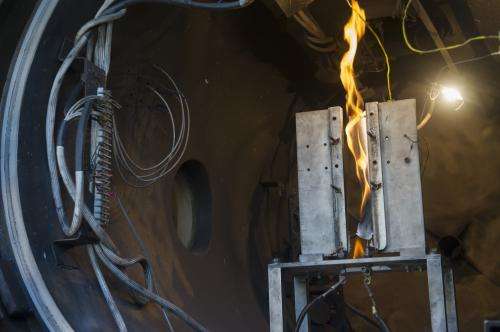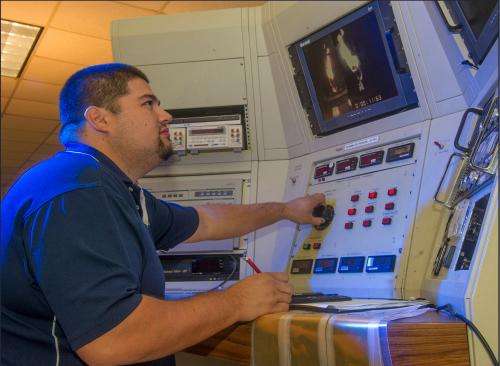Marshall Center lighting the match to learning more about fires in space

(Phys.org)—Fast forward. A crew of astronauts is on its way to explore the red depths of Mars. A piece of equipment catches fire along the journey. What's the best way for astronauts to quickly extinguish that fire in conditions beyond low-Earth orbit? Or avoid a fire even starting?
Engineers at NASA's Marshall Space Flight Center in Huntsville are hoping to answer those questions—and many others—through a series of tests and studies being conducted at Marshall and four other NASA facilities—Glenn Research Center in Cleveland, the lead center for the project; Johnson Space Center in Houston; the Jet Propulsion Laboratory in Pasadena, Calif.; and the White Sands Test Facility in Las Cruces, N.M. The combined test data will be used to help design a future large-scale fire experiment in space.
The collaborative, three-year project is part of NASA's Advanced Exploration Systems, or AES, program—pioneering new approaches for rapidly developing prototype systems, demonstrating key capabilities and validating operational concepts for future human missions beyond low-Earth orbit. AES activities are uniquely related to crew safety and mission operations in deep space, and are strongly coupled to future vehicle development.

"NASA has been interested in furthering our understanding of fires outside the Earth's atmosphere for quite some time," said Harry Wise, a Victory Solutions Inc. employee—under the Jacob's Engineering and Science Services and Skills Augmentation contract—supporting Marshall's Materials & Processes Laboratory. He is a lead for the fire testing at Marshall. "We've always had the goal to do some fire safety studies and experiments to advance that capability, so we're excited to be part of this project.
"Basically, our whole risk strategy for fire right now is based on low-Earth orbit protocols. On the space shuttle, the astronauts could close the doors and come home if there was a fire event. With NASA's new exploration goals going beyond low-Earth orbit, astronauts will need the means necessary to extinguish a fire quickly and safely. These experiments will help us learn more about various fire safety issues, including low-gravity material flammability, fire suppression and post-fire cleanup."
Marshall's piece of the puzzle, so to speak, is to recommend the best material to set aflame for the large-scale test. Hundreds of test samples have been narrowed down to seven different materials. Each material is put into a test chamber, filled with varying pressure levels of nitrogen and oxygen—mimicking conditions aboard a spacecraft. Testing is being done at Marshall's Materials and Processes Laboratory.
Data, including the maximum oxygen concentration at which a propagating flame will go out, is collected while the samples are kindled with varying energies. Each sample is tested several ways, including being lit by different igniter types. The current plan is for one material to be chosen for the large-scale test. "We want to make sure the material for the test will be 100 percent flammable in an orbital environment," said Wise. Once the best two to three sample materials are determined, they will be sent to Glenn Research Center for further testing in a zero-gravity drop tower.
Marshall is also helping with the Burning and Suppression of Solids, or BASS II, feasibility study. BASS II would be a "big brother" to the BASS experiment, an existing fire testing experiment being performed on the International Space Station. "The BASS experiment is similar to our current fire testing, but its capabilities are small compared to what we want to do," said Wise. "BASS material samples are about the size of a stick of gum. We want to provide larger materials for that experiment that burn longer, and ultimately, build a bigger, better BASS."
More information: www.nasa.gov/directorates/heo/aes/index.html
Provided by NASA




















